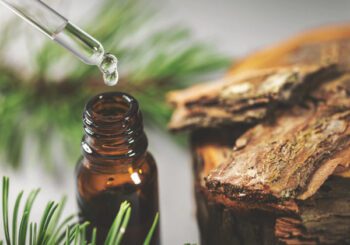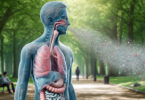By Sayer Ji
Contributing Writer for Wake Up World
Pine bark extract (PE), trade name Pycnogenol (pronounced “pig-nah-gen-all”), has many beneficial properties such as being anti-inflammatory, antioxidant and neuroprotective. It can help with memory, cognition, inattention, hyperactivity, mood, thinking and various symptoms of brain injuries, aging and neurological diseases.
1. Fights Inflammation and Protects the Brain
In a systematic review and meta-analysis of Pycnogenol supplementation on C-reactive protein (CRP) — a marker of oxidative stress — researchers examined five trials including 324 participants. Pycnogenol supplementation had a significant effect in reducing CRP and demonstrated a strong anti-inflammatory effect.[i]
In a study of gerbils, pine bark extract was administered at 100 milligrams (mg) per kilogram (kg) once a day for seven days before the brain was submitted to a brain ischemic injury.
The PE treatment markedly inhibited the death of neurons in the brain, significantly decreased the pro-inflammatory cytokines — interleukin 1? and tumor necrosis factor ? — and showed a strong activation effect on anti-inflammatory cytokines of interleukin 4 (IL-4) and interleukin 13 (IL-13). Pine bark protected the brain and decreased inflammation.[ii]
2. Improves Attention, Memory, Executive Functions and Mood in Healthy People
In a study over eight weeks, Pycnogenol supplementation improved sustained attention, memory, executive functions and mood ratings in 53 healthy students compared to an equivalent control group.[iii]
In a trial of 60 healthy professionals from 35 to 55 years old, half of the participants supplemented with Pycnogenol of 50 mg three times a day for 12 weeks in combination with a controlled health plan — regular sleep, balanced meals and daily exercise — and the other half followed only the health plan as the control group.
PE significantly improved mood by 16%, mental performance by 9%, attention by 13% and memory by 4%, and reduced oxidative stress by 30%, outperforming all results of the control group.[iv]
3. Prevents Brain Aging and Cognitive Decline
Brain aging is a complex process involving changes in the brain’s structure, neuron activity and biochemical profile that has been linked to age-associated variations in cognitive function. Increased oxidative stress may also be an important factor related to reduced cognition in older people.
In a systematic review of over 100 research trials and animal studies, the antioxidant Pycnogenol significantly improved cognitive function after chronic administration.[v]
4. Improves Cognition and Stress in the Mildly Impaired or Highly Oxidative Stressed
Eighty-seven healthy subjects with mild cognitive impairment scores were included in a trial with one group given standard management (SM) and the other half given Pycnogenol supplements for two months. The median increase in mild impairment scores was 18% with Pycnogenol compared to 2.48% in the SM group, largely due to its effects on oxidative stress levels.[vi]
In a study of 88 healthy patients ages 55 to 70 who had high oxidative stress, half were supplemented with 100 mg per day of Pycnogenol for 12 months and the other half were the control group followed as a reference point for a year. Those in the pine bark group had significantly improved cognitive function scores, attention and mental performance and lowered oxidative stress levels compared to those in the reference group.[vii]
5. Increases Cognitive Function and Helps Symptoms in Parkinson’s Disease
Researchers studied 43 Parkinson’s disease (PD) patients who had been diagnosed at least one year before the trial. The condition was considered “mild,” with minimal progression.
The standard management (SM) for PD — carbidopa/levodopa — was used in a similar-sized reference group of PD subjects for comparison purposes. The trial subjects were supplemented with Pycnogenol of 150 mg per day along with SM for a period of four weeks.
Cognitive function was significantly higher with the Pycnogenol group. Target symptoms including tremors, rigidity, bradykinesia — slow or impaired movements in limbs — and speech were improved in the PE group compared to the control group. Oxidative stress was also significantly lower in the pine bark group at four weeks.[viii]
6. Enhances Memory and Prevents Harmful Plaque and Tau Buildup in Alzheimer’s Disease
In Alzheimer’s disease (AD), the release of amyloid-beta (A?) is a marker. A? aggregates into oligomers, then plaques, which induce inflammatory responses, synapse loss and misfolding of tau, a second hallmark of AD. Accumulation of tau misfolding leads to tangles in the brain and neuron cell death impacting brain synapses in a pattern of progression closely related to cognitive decline, which can happen years before memory loss symptoms even appear.[ix]
Pycnogenol significantly decreased the number of plaques in both pre-onset and post-onset treatment paradigms and improved spatial memory in the pre-onset treatment only in an AD-induced mouse model.[x]
In an in vitro study of AD-induced animals, pine bark — Oligopin — prevented and halted the progression of AD preclinically by inhibiting oligomer formation of not only A?1-40 and A?1-42, but also tau in vitro.[xi]
7. Reduces Inflammation and Improves Outcomes for Traumatic Brain Injuries
In a scientific trial of 67 traumatic brain injury (TBI) patients admitted to an intensive care unit (ICU), the intervention group received 150 mg of the PE supplement Oligopin with enteral nutrition — tube feeding through stomach or intestine — for 10 days while the control group received a placebo.[xii]
Pine bark supplementation significantly decreased inflammatory biomarkers of IL-6, IL-1? and CRP compared to the control group after 10 days. In addition, pine bark reduced clinical scores for acute physiology and chronic health evaluation as well as sequential organ failure. The Nutric score — a way to measure if a patient is under-nourished and at critical risk of dying[xiii] — was reduced compared to the control group as well.
Overall, the survival rate was 15% higher in the pine bark group compared to the placebo group. PE supplementation for TBI patients in ICUs reduced inflammation, improved their clinical status and malnutrition score and, thereby, reduced their mortality rate.
8. Improves Attention, Focus, Thinking, Behavior and Antioxidant Levels in ADHD
Attention deficit hyperactivity disorder (ADHD) is a neurodevelopmental disorder characterized by impulsivity, distractibility and hyperactivity. One of the factors associated with ADHD is oxidative stress. Pycnogenol consists of bioflavonoids, catechins, procyanidins and phenolic acids.[xiv]
Pycnogenol acts as a powerful antioxidant stimulating certain enzymes, like superoxide dismutase (SOD) and endothelial nitric oxide synthase (eNOS), which can defend against oxidative stress. In the pathophysiology of ADHD, damage to adrenaline, noradrenaline and dopamine metabolism occurs in the brain. These changes can modify attention, thinking and acting.[xv]
Researchers often analyze levels of glutathione (GSH) as it is the most abundant antioxidant in aerobic cells, present in bodily fluids and tissues. GSH is critical for protecting the brain from oxidative stress, acting as a free radical scavenger and inhibitor of lipid peroxidation. The ratio of reduced GSH to oxidized GSH (GSSG) is an indicator of cellular health, with reduced GSH making up to 98% of cellular GSH under normal conditions. However, the reduced GSH to GSSG ratio is lower in neurological conditions such as ADHD, Parkinson’s disease and Alzheimer’s disease.[xvi]
In a trial of 43 children ages 6 to 14 with ADHD, patients were administered Pycnogenol — 1 mg per kg of body weight every day — or a placebo of look-alike pills daily for a month. The PE group had a significant decrease in GSSG and a highly significant increase in GSH levels as well as improvement of GSH/GSSG ratio in comparison to the placebo group. The total antioxidant status (TAS) decreased in children with ADHD who took pine bark, showing a normalization of TAS in ADHD children.[xvii]
In a crossover study of 20 children with ADHD, participants experienced two experimental units — four weeks of pine bark supplementation with 25 or 50 mg PE and four weeks with placebo supplementation — separated by two weeks of a washout period. PE supplementation caused a significant reduction in inattention and hyperactivity-impulsivity measures.
Two methods of assessing antioxidant potential of dietary components were used in this study. The levels of reduced GSH and the ratio of reduced GSH to GSSH was the first method used. Thiobarbituric acid reactive substance (TBARS) was the second method used to detect lipid oxidation. TBARS specifically measures malondialdehyde (MDA), which results from oxidation of lipid substrates.[xviii]
PE supplementation for four weeks found the reduced GSH/oxidized GSH ratio significantly increased and the plasma TBARS level significantly decreased. Researchers showed taking pine bark has potentially strong effects of ameliorating inattention and impulsivity and elevating the antioxidative status in children with ADHD.[xix]
Sixty-one children with ADHD who supplemented with 1 mg per kg per day of Pycnogenol for over a month had significant reduction of hyperactivity and improved attention and concentration compared to the control group that was given a placebo.[xx]
Powerful Properties of Pine Bark or Pycnogenol
From positive benefits on memory, cognitive function, mood, thinking, hyperactivity, attention, focus and improvements or prevention of neurological diseases and disorders like ADHD, PD and AD, Pycnogenol or PE delivers strong brain protection and healthier outcomes. See more on GreenMedInfo.com’s scientific evidence regarding neurological disorders, brain inflammation, cognitive decline/dysfunction, learning disorders and pine bark extract / Pycnogenol.
References:
[i] Nikpayam O, Rouhani MH, Pourmasoumi M, Roshanravan N, Ghaedi E, Mohammadi H. The Effect of Pycnogenol Supplementation on Plasma C-Reactive Protein Concentration: A Systematic Review and Meta-Analysis. Clin Nutr Res. 2018 Apr;7(2):117-125. doi: 10.7762/cnr.2018.7.2.117. Epub 2018 Apr 16. PMID: 29713620; PMCID: PMC5921329.
[ii] Joon Ha Park, Jong Dai Kim, Tae-Kyeong Lee, Xionggao Han, Hyejin Sim, Bora Kim, Jae-Chul Lee, Ji Hyeon Ahn, Choong-Hyun Lee, Dae Won Kim, Moo-Ho Won, Soo Young Choi. Neuroprotective and Anti-Inflammatory Effects ofBark Extract in Gerbil Hippocampus Following Transient Forebrain Ischemia. Molecules. 2021 Jul 29 ;26(15). Epub 2021 Jul 29. PMID: 34361744
[iii] R Luzzi, G Belcaro, C Zulli, M R Cesarone, U Cornelli, M Dugall, M Hosoi, B Feragalli. Pycnogenol® supplementation improves cognitive function, attention and mental performance in students. Panminerva Med. 2011 Sep ;53(3 Suppl 1):75-82. PMID: 22108481
[iv] Belcaro, G. , Luzzi R. , Dugall, M. , Ippolito, E., Saggino A. Pycnogenol improves cognitive function, attention, mental performance and specific professional skills in healthy professionals aged 35-55. Journal of Neurosurgical Sciences 2014, December; 58(4):239-48.
[v] Tamara Simpson, Christina Kure, Con Stough. Assessing the Efficacy and Mechanisms of Pycnogenol on Cognitive Aging From Animal and Human Studies. Front Pharmacol. 2019 ;10:694. Epub 2019 Jul 3. PMID: 31333448
[vi] Morio Hosoi, Gianni Belcaro, Aristide Saggino, Roberta Luzzi, Mark Dugall, Beatrice Feragalli. Pycnogenol® supplementation in minimal cognitive dysfunction. J Neurosurg Sci. 2018 Jun ;62(3):279-284. PMID: 29754480
[vii] G Belcaro, M Dugall, E Ippolito, S Hu, A Saggino, B Feragalli. The COFU3 Study. Improvement in cognitive function, attention, mental performance with Pycnogenol® in healthy subjects (55-70) with high oxidative stress. J Neurosurg Sci. 2015 Dec ;59(4):437-46. PMID: 26635191
[viii] Maria Rosaria Cesarone, Gianni Belcaro, Morio Hosoi, Andrea Ledda, Beatrice Feragalli, Claudia Maione, Claudia Scipione, Valeria Scipione, Roberto Cotellese, Shuh Hu. Supplementary management with Pycnogenol® in Parkinson’s disease to prevent cognitive impairment. J Neurosurg Sci. 2020 Jan 20. Epub 2020 Jan 20. PMID: 31957998
[ix] Hodson, Richard Alzheimer’s Disease, Nature, 2018, July 18; 559(7715):51
[x] K Paarmann, S R Prakash, M Krohn, L Möhle, M Brackhan, T Brüning, I Eiriz, J Pahnke. French maritime pine bark treatment decelerates plaque development and improves spatial memory in Alzheimer’s disease mice. Phytomedicine. 2018 Nov 29 ;57:39-48. Epub 2018 Nov 29. PMID: 30668321
[xi] Kenjiro Ono, Daisy Zhao, Qingli Wu, James Simon, Jun Wang, Aurelian Radu, Giulio Maria Pasinetti. Pine Bark Polyphenolic Extract Attenuates Amyloid-? and Tau Misfolding in a Model System of Alzheimer’s Disease Neuropathology. J Alzheimers Dis. 2020 Jan 13. Epub 2020 Jan 13. PMID: 31958081
[xii] Malekahmadi M, Shadnoush M, Islam SMS, Shirvani A, Pahlavani N, Gholizadeh Navashenaq J, Firouzi S, McVicar J, Nematy M, Zali MR, Moradi Moghaddam O, Norouzy A. The effect of French maritime pine bark extract supplementation on inflammation, nutritional and clinical status in critically ill patients with traumatic brain injury: A randomized controlled trial. Phytother Res. 2021 Sep;35(9):5178-5188. doi: 10.1002/ptr.7187. Epub 2021 Aug 12. PMID: 34382717.
[xiii] Heyland DK, Dhaliwal R, Jiang X, Day AG. Identifying critically ill patients who benefit the most from nutrition therapy: the development and initial validation of a novel risk assessment tool. Crit Care. 2011;15(6):R268. doi: 10.1186/cc10546. Epub 2011 Nov 15. PMID: 22085763; PMCID: PMC3388687.
[xiv] Packer L, Rimbach G, Virgili F. Antioxidant activity and biologic properties of a procyanidin-rich extract from pine (Pinus maritima) bark, pycnogenol. Free Radic Biol Med. 1999 Sep;27(5-6):704-24. doi: 10.1016/s0891-5849(99)00090-8. PMID: 10490291.
[xv] Grima G, Benz B, Parpura V, Cuénod M, Do KQ. Dopamine-induced oxidative stress in neurons with glutathione deficit: implication for schizophrenia. Schizophr Res. 2003 Aug 1;62(3):213-24. doi: 10.1016/s0920-9964(02)00405-x. PMID: 12837517.
[xvi] Owen JB, Butterfield DA. Measurement of oxidized/reduced glutathione ratio. Methods Mol Biol. 2010;648:269-77. doi: 10.1007/978-1-60761-756-3_18. PMID: 20700719
[xvii] Monika Dvoráková, Monika Sivonová, Jana Trebatická, Igor Skodácek, Iveta Waczuliková, Jana Muchová, Zdenka Duracková. The effect of polyphenolic extract from pine bark, Pycnogenol on the level of glutathione in children suffering from attention deficit hyperactivity disorder (ADHD). Redox Rep. 2006;11(4):163-72. PMID: 16984739
[xviii] Shashank Kumar, Rapalli Krishna Chaitanya, & Victor R. Preedy, Chapter 20 – Assessment of Antioxidant Potential of Dietary Components, Edited by Victor R. Preedy and Ronald Ross Watson, HIV/AIDS, Academic Press, 2018, Pages 239-253, https://doi.org/10.1016/B978-0-12-809853-0.00020-1.
[xix] Hsu CD, Hsieh LH, Chen YL, Lin IC, Chen YR, Chen CC, Shirakawa H, Yang SC. Complementary effects of pine bark extract supplementation on inattention, impulsivity, and antioxidative status in children with attention-deficit hyperactivity disorder: A double-blinded randomized placebo-controlled cross-over study. Phytother Res. 2021 Jun;35(6):3226-3235. doi: 10.1002/ptr.7036. Epub 2021 Feb 8. PMID: 33559134.
[xx] Trebatická, J., Kopasová, S., Hrade?ná, Z. et al. Treatment of ADHD with French maritime pine bark extract, Pycnogenol® . Eur Child Adolesc Psychiatry 15, 329-335 (2006). doi.org/10.1007/s00787-006-0538-3
About the author:
Sayer Ji is the founder of Greenmedinfo.com, a reviewer at the International Journal of Human Nutrition and Functional Medicine, Co-founder and CEO of Systome Biomed, Vice Chairman of the Board of the National Health Federation, and Steering Committee Member of the Global Non-GMO Foundation.
© 2020 GreenMedInfo LLC. This work is reproduced and distributed with the permission of GreenMedInfo LLC. Want to learn more from GreenMedInfo? Sign up for their newsletter here.

If you've found value in our articles, we invite you to support the release of our brand-new book, "Gratitude Practices for Kids: A Practical Guide for Adults to Instill a Spirit of Appreciation and Positivity in the Next Generation."
"Gratitude Practices for Kids" brings together over 25 innovative and accessible practices designed to enhance gratitude in everyday life. This comprehensive guide is backed by 17 scientific studies, ensuring each concept is grounded in research, underscoring our commitment to nurturing growth, emotional intelligence, and positive interactions between adults and children.
We encourage you to opt for the paperback version to celebrate this new release. Dive into its fresh pages away from digital distractions, allowing you to immerse yourself in the transformative practices it offers.
Over recent years, Wake Up World has faced significant online censorship, which has impacted our financial ability to operate. Moving into book publishing represents a strategic step to secure the ongoing funds needed to continue our mission. By purchasing Gratitude for Kids, you help us keep our content free and accessible to everyone, avoiding needing a paywall. With over 8,500 articles published in the last 13 years, we remain dedicated to keeping our valuable content open to all.









